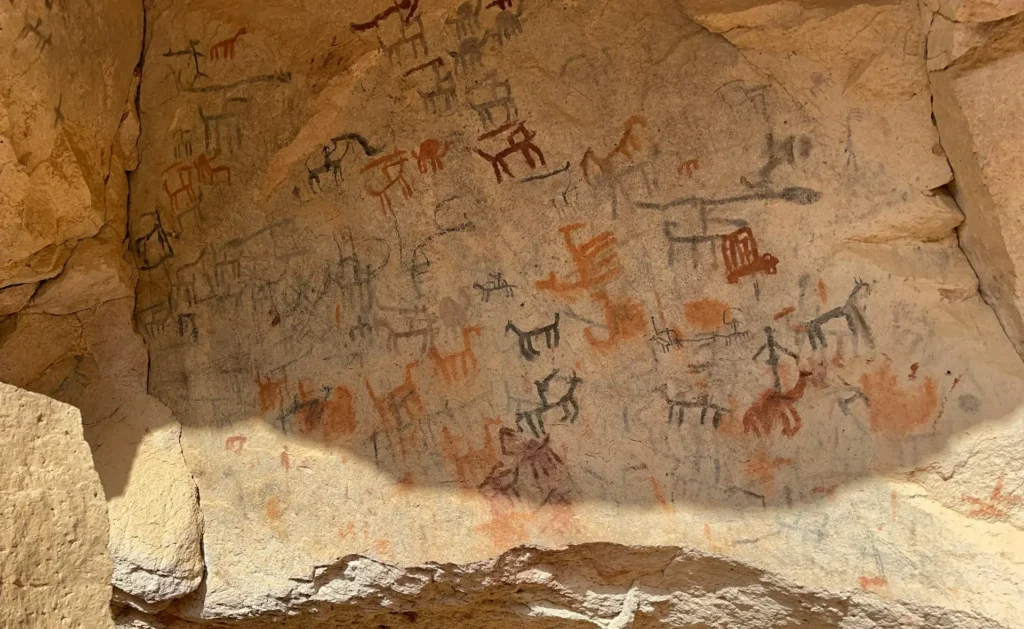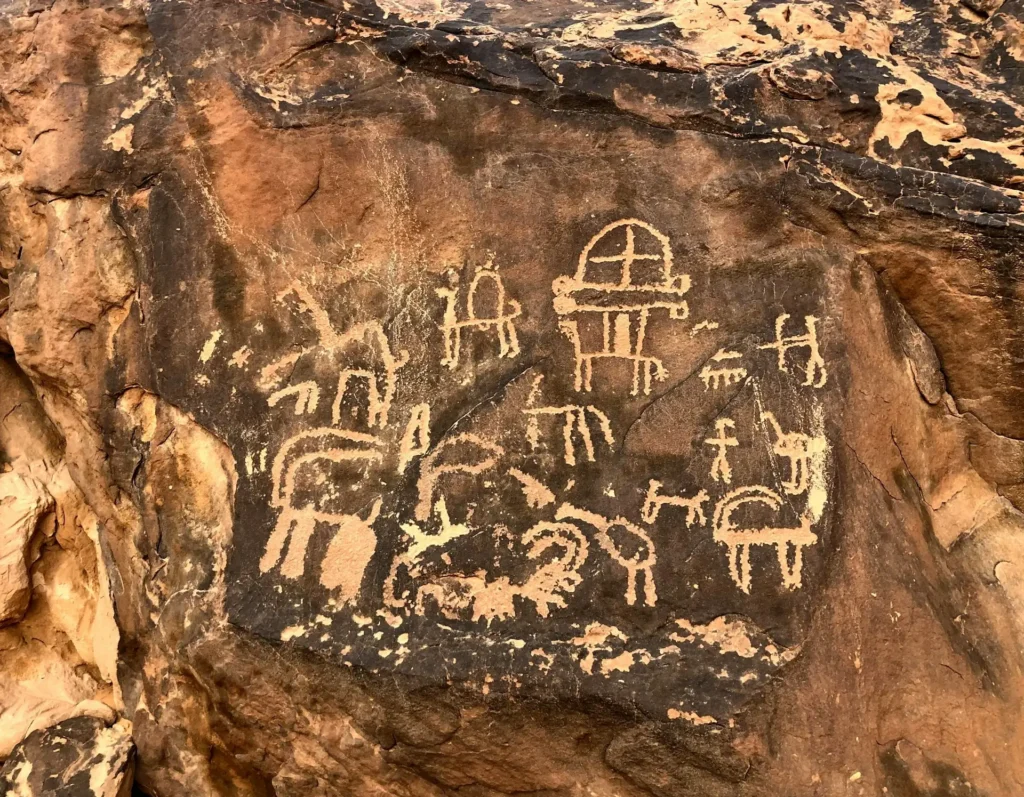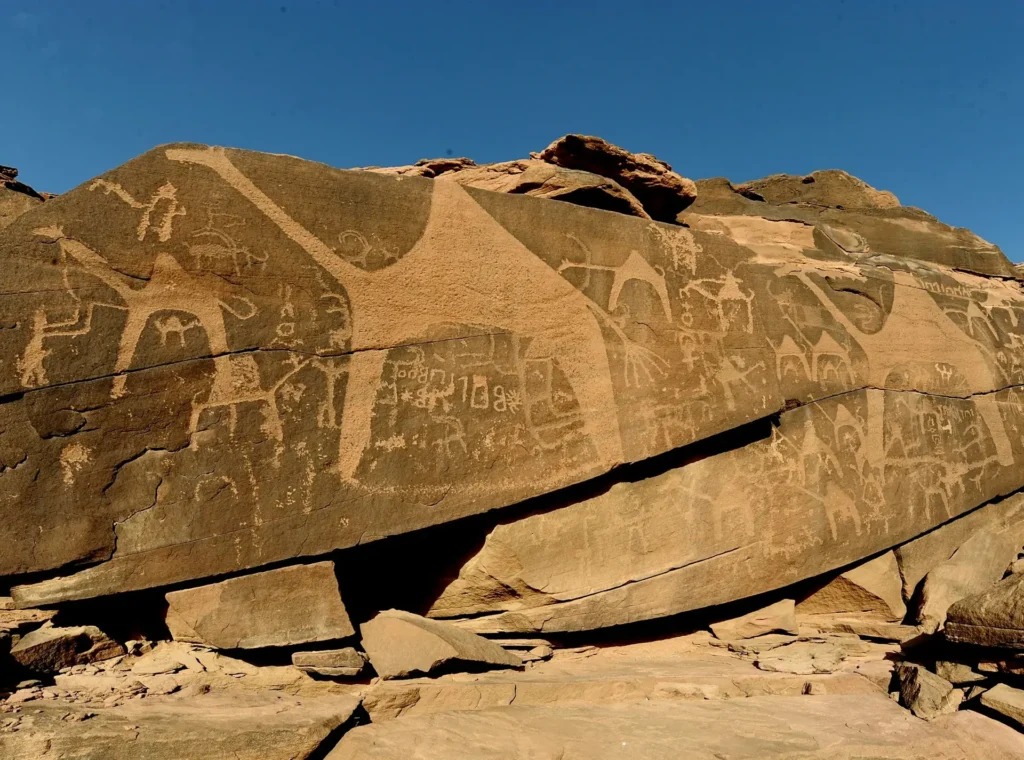Imagine standing in the vast, silent desert, where the whispers of ancient civilizations echo through the intricate carvings on towering rock faces. The wind carries stories of a time long forgotten, and the sun illuminates the artistry of people who walked these lands thousands of years ago. This is the magic of Saudi Arabia’s rock art, a treasure trove of human history hidden in plain sight.
For history buffs, adventure seekers, and culture enthusiasts, the rock art of Jubbah and Shuwaymis offers a rare glimpse into the lives of our ancestors. These ancient masterpieces, etched into the stone canvas of the desert, are more than just art—they are a window into the past, a testament to human creativity, and a reminder of our shared heritage.
In this article, we’ll take you on a journey to explore Saudi Arabia’s best-kept secret: the rock art of Jubbah and Shuwaymis. From its historical significance to practical tips for visiting, you’ll discover why these sites deserve a spot on your travel bucket list.
The Enigmatic Rock Art of Jubbah and Shuwaymis: A Historical Overview
What is Saudi Arabia Rock Art?
Rock art refers to carvings, engravings, or paintings on natural stone surfaces. In Saudi Arabia, the sites of Jubbah and Shuwaymis are home to some of the most remarkable examples of this ancient art form. Located in the Hail region of northern Saudi Arabia, these sites feature thousands of petroglyphs—images carved into rock—that depict scenes of daily life, wildlife, and symbolic motifs.
In 2015, UNESCO recognized the rock art of Jubbah and Shuwaymis as World Heritage Sites, highlighting their global significance. These carvings are not just artistic expressions; they are historical records that provide invaluable insights into the lives of prehistoric communities.
A Window into Ancient Civilizations
The rock art of Jubbah and Shuwaymis dates back over 10,000 years, making it one of the oldest known forms of human expression in the Arabian Peninsula. The carvings depict a variety of themes, including:
- Hunting scenes: Images of humans hunting animals like ibex, camels, and even ostriches.
- Wildlife: Depictions of animals that once roamed the region, some of which are now extinct.
- Human figures: Engravings of people engaged in activities like dancing, fighting, and herding.
- Ancient scripts: Inscriptions in Thamudic and other early Arabian scripts.
These carvings offer a fascinating glimpse into the lives, beliefs, and environments of the people who created them. They tell stories of survival, creativity, and the deep connection between humans and nature.

Why Jubbah and Shuwaymis Are Saudi Arabia’s Best-Kept Secrets
Remote and Untouched Beauty
One of the reasons the rock art of Jubbah and Shuwaymis remains relatively unknown is its remote location. Nestled in the heart of the desert, these sites are far from the bustling cities and tourist hotspots. The journey to reach them is an adventure in itself, taking you through stunning landscapes of sand dunes, rocky outcrops, and vast open skies.
The remoteness of these sites has also helped preserve the rock art. Unlike more accessible heritage sites, Jubbah and Shuwaymis have remained largely untouched by modern development, allowing the carvings to survive for millennia.
Lesser-Known Compared to Other Global Sites
When you think of rock art, places like Lascaux Cave in France or the Bhimbetka rock shelters in India might come to mind. While these sites are undoubtedly remarkable, the rock art of Jubbah and Shuwaymis is equally deserving of recognition.
Despite their historical and cultural significance, these sites remain under the radar for many travelers. This lack of awareness makes them a hidden gem for those willing to venture off the beaten path.

The Cultural and Historical Significance of Saudi Arabia Rock Art
Insights into Prehistoric Life
The rock art of Jubbah and Shuwaymis provides a unique window into prehistoric life in the Arabian Peninsula. The carvings depict a world that was vastly different from the one we know today. For example:
- Extinct animals: Some of the engravings show animals like elephants and ostriches, which no longer inhabit the region.
- Early human migration: The presence of certain motifs and styles suggests connections to other ancient cultures across the Middle East and Africa.
These insights help archaeologists and historians piece together the puzzle of human history, shedding light on how early societies lived, adapted, and thrived in challenging environments.
A Testament to Human Creativity
The rock art of Jubbah and Shuwaymis is not just a historical record—it’s a masterpiece of human creativity. The carvings showcase a variety of artistic techniques, from simple outlines to intricate details. Over time, the styles evolved, reflecting changes in culture, technology, and environment.
What’s truly remarkable is the sheer scale of these sites. Thousands of carvings cover the rock faces, each one a testament to the skill and imagination of its creator.
Visiting Jubbah and Shuwaymis: A Traveler’s Guide
How to Get There
Jubbah and Shuwaymis are located in the Hail region of northern Saudi Arabia. The nearest major city is Hail, which is well-connected by road and air. From Hail, you can hire a guide or join a tour to reach the rock art sites.
The best time to visit is during the cooler months, from October to March, when the weather is more comfortable for exploring the desert.
What to Expect
When you arrive at Jubbah or Shuwaymis, you’ll be greeted by a breathtaking landscape of rocky outcrops and desert vistas. The rock art is spread across large areas, so be prepared for some walking.
Guided tours are highly recommended, as local experts can provide valuable insights into the history and significance of the carvings. Remember to respect the sites by not touching the carvings or leaving any litter behind.
Nearby Attractions
While you’re in the Hail region, consider exploring other nearby attractions, such as:
- Al-Qishlah Fort: A historic fortress in the city of Hail.
- A’arif Fort: Another iconic landmark offering panoramic views of the city.
- The Nefud Desert: A stunning desert landscape perfect for photography and adventure.
Preserving Saudi Arabia Rock Art for Future Generations
Challenges to Preservation
Despite their remote location, the rock art sites of Jubbah and Shuwaymis face several threats, including:
- Natural erosion: Wind, rain, and temperature fluctuations can damage the carvings over time.
- Human impact: Vandalism and irresponsible tourism pose significant risks to the sites.
Conservation Efforts
The Saudi government, in collaboration with UNESCO, has taken steps to protect and preserve these invaluable heritage sites. Efforts include:
- Monitoring and maintenance: Regular inspections and conservation work to prevent further damage.
- Education and awareness: Programs to educate locals and visitors about the importance of preserving the rock art.
As a visitor, you can contribute to these efforts by following guidelines, respecting the sites, and spreading awareness about their significance.
Conclusion:
The rock art of Jubbah and Shuwaymis is more than just an archaeological wonder, it’s a bridge to our past and a source of inspiration for the future. These ancient carvings remind us of the creativity, resilience, and ingenuity of our ancestors, and they challenge us to preserve and protect our shared heritage.
If you’re planning a trip to Saudi Arabia, make sure to include Jubbah and Shuwaymis on your itinerary. These hidden gems offer a unique opportunity to connect with history, explore stunning landscapes, and experience the magic of the desert.
FAQ about Saudi Arabia rock art
What is the significance of Saudi Arabia rock art?
The rock art provides a unique glimpse into prehistoric life and early human creativity, offering valuable insights into the history and culture of the region.
Where are Jubbah and Shuwaymis located?
Both sites are located in the Hail region of northern Saudi Arabia.
Can anyone visit the rock art sites?
Yes, but it’s recommended to go with a guide and follow preservation guidelines to protect the sites.
How old is the rock art in Saudi Arabia?
Some carvings date back over 10,000 years, making them among the oldest in the world.
Why is Saudi Arabia’s rock art considered a “best-kept secret”?
Despite its historical importance, it remains lesser-known compared to other global heritage sites, making it a hidden gem for travelers.
